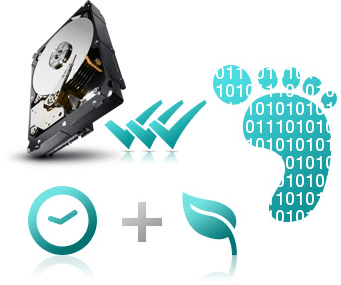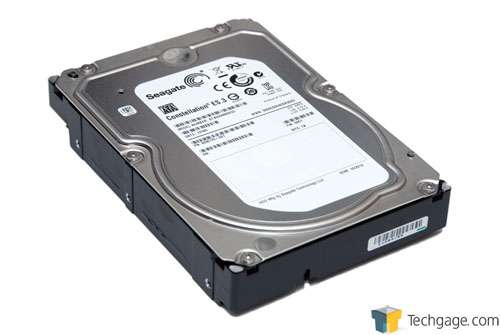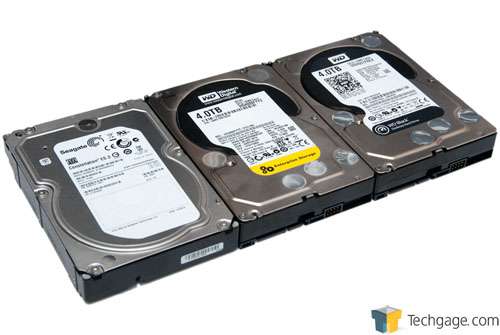- Qualcomm Launches Snapdragon 4 Gen 2 Mobile Platform
- AMD Launches Ryzen PRO 7000 Series Mobile & Desktop Platform
- Intel Launches Sleek Single-Slot Arc Pro A60 Workstation Graphics Card
- NVIDIA Announces Latest Ada Lovelace Additions: GeForce RTX 4060 Ti & RTX 4060
- Maxon Redshift With AMD Radeon GPU Rendering Support Now Available
Seagate Constellation ES.3 4TB Enterprise Hard Drive Review

We took a look at both of WD’s 4TB hard drive options in the past month, so it’s a great time to get some Seagate action going. The Constellation ES.3 competes with WD’s RE in the enterprise space, but it brings an interesting feature to the table: a 128MB cache. So let’s give the the drive a good test and see if it can topple the RE drive we raved over.
Page 1 – Introduction
With a mere 3 options for the consumer and 3 for the enterprise, the current 4TB market is small. Where’s our “Green” option from Seagate? WD? HGST? Your guess is as good as ours.
While the consumer 4TB situation at the moment is depressing, the enterprise one isn’t. All three of the aforementioned vendors have been taking good care of their IT friends with a collection of both SATA and SAS models, and Seagate in particular has done a couple of things to help its model stand apart from the rest.
For starters, the company’s ES.3 4TB drive is the first on the planet that implements 128MB of on-board cache – up from 64MB, which might as well be considered a standard. What does that extra cache mean for the user? That’s a great question, and one that’s difficult to give a definitive answer for.
The purpose of cache on a hard drive is to act as a buffer so as to improve the flow of data from or to the drive. In conjunction with the drive’s controller, it can hold pre-fetched data that the OS has not yet requested, but is expected to. As an example, while you may be reading page 1 of a document, the cache might already be storing page 2. This can reduce or eradicate the load time for the page transition. On the flip-side, the cache can also allow the OS to flag a data write as having been completed, even though the cache is still in the process of moving the data to the appropriate sectors.
It stands to reason that a doubling of the cache could in effect double the performance of the buffer – it’s just logical. However, at this micro-transaction level, the performance differences are very likely to be invisible to the naked eye, and much like with faster RAM, differences that could be seen would have to be very specific. As we’ll see in our results coming up shortly, Seagate’s ES.3 4TB does prove to be faster in most cases than WD’s RE 4TB, which shares similar specs aside from the cache.
While working on this review, and with results in hand, we talked to WD to see if it had plans to roll-out models equipped with 128MB of cache in the future. We were told:
We aren’t expected to as of today. We always make sure there is a balance, and if there is no expected gain by additional cache, then there is no reason for it other than to increase the cost.
It’s hard to fault that reasoning.
Let’s go a little off-track here for a moment. This article has been in production for a couple of weeks, during which time I’ve been awaiting answers from Seagate regarding some performance oddities that we’ll discuss later. If not for those questions, this article would have been published weeks ago. However, because of the delay, I was forced to change the intro at the top from “5” drives to “6”. That’s right, another has joined the fray, and it’s a strange one.
| Speed | Cache | Warranty | Usage | Price | |
| Seagate Constellation ES.3 (ST4000NM0033) |
7,200 RPM | 128 MB | 5-year | Enterprise | ~$415 |
| WD RE (WD4000FYYZ) |
7,200 RPM | 64 MB | 5-year | Enterprise | ~$410 |
| HGST Ultrastar 7K4000 (HUS724040ALE640) |
7,200 RPM | 64 MB | 5-year | Enterprise | ~$440 |
| WD Black (WD4001FAEX) |
7,200 RPM | 64 MB | 5-year | Performance | ~$330 |
| HGST (H3IK40003272SW) |
7,200 RPM | 64 MB | 3-year | Performance | ~$310 |
| Seagate Desktop HDD.15 (ST4000DM000) |
7,200 RPM | 64 MB | 2-year | Storage | ~$210 |
Yup – we’re looking at a 4TB hard drive that costs a mere $210. Despite its lower price, it’s still spec’d at 7,200RPM and has a 64MB cache. The biggest difference is that it drops the warranty down to 2-years, though we’d imagine that the real-world performance might be a bit lower as well. According to Amazon, there’s also an ST4000DX001 model that includes 128MB of cache like this ES.3 drive, but there’s no mention of it whatsoever on Seagate’s own site.
Given its pricing, the ST4000 is a hard option to ignore. Personally, I am undecided as to whether or not I’d opt for a drive that has only a 2-year warranty given they will likely be used for long-term storage – but that problem becomes lessened if a redundant setup is involved. It’s going to be interesting to see how WD or HGST counter this drive.

Reading around, it’s hard to figure out whether or not the ES.3 drive features 4 or 5 platters. Given the performance we’re going to be taking a look at in a moment, I’m willing to bet it does in fact use 4, meaning we’re dealing with 1TB platters in lieu of 800GB ones like the other 4TB drives. Thanks to the increased areal density, performance is naturally increased – it’s a design we can certainly get behind.
It’s worth noting that while only a single ES.3 model is listed in the table above, two others exist. The ST4000NM0053 adds hardware encryption to the mix, and costs $440 for either the SATA or SAS version. Then there’s the ST4000NM0063, a SAS-only drive that implements FIPS – a government-mandated encryption standard.
Regarding enterprise features, Seagate and WD do not differ too much. Seagate offers a 1.4 million hours mean-time before failure rating, up from WD’s 1.2 millon, but both offer enhanced error correction, vibration tolerences, low power consumption, dual processors, ramp load technology and built-in sensors for best operation. One advantage Seagate does have with the current generation is that it offers the hardware encryption options mentioned above. Neither WD or HGST currently do, though it is expected that HGST will at some point.
With that, let’s head on into a quick look at our testing methodology and then get to the first results.
Support our efforts! With ad revenue at an all-time low for written websites, we're relying more than ever on reader support to help us continue putting so much effort into this type of content. You can support us by becoming a Patron, or by using our Amazon shopping affiliate links listed through our articles. Thanks for your support!







